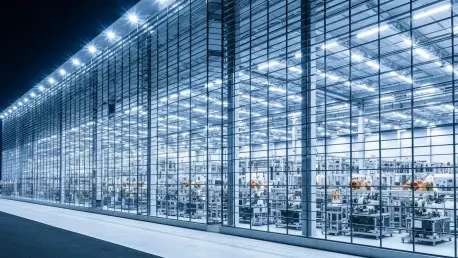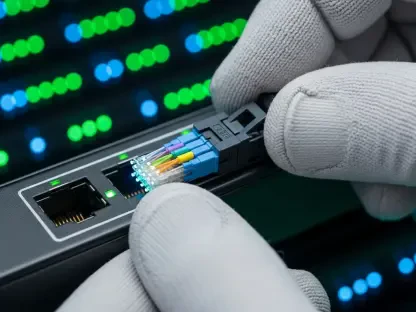In a world where artificial intelligence dictates the pace of global innovation, Europe finds itself at a critical crossroads, grappling with a stark deficit in AI infrastructure compared to powerhouses like the US and China, while one company, Deutsche Telekom (DT), steps forward with an ambitious plan. Picture a continent racing to secure its technological sovereignty, with DT aiming to build an AI Gigafactory in Germany—a project that could either catapult Europe into the AI elite or falter under its own ambition. This bold move raises a pressing question: can a single telecom giant redefine an entire region’s digital destiny?
The significance of this endeavor cannot be overstated. With the European Commission’s InvestAI initiative pushing for enhanced digital capabilities, DT’s project emerges as a cornerstone in the fight for data security and independent AI development. This story isn’t just about a factory; it’s about Europe’s chance to claim a seat at the global tech table, addressing real-world challenges like innovation gaps and economic competitiveness. The stakes are monumental, and the outcome could shape millions of lives across the continent.
Why Europe Is Betting Big on an AI Powerhouse
Europe’s lag in AI compute power has become a glaring vulnerability, threatening its ability to compete on the global stage. Reports from the European Commission indicate that the region possesses less than 15% of the high-performance computing capacity held by the US, a statistic that underscores the urgency of projects like DT’s AI Gigafactory. This disparity isn’t merely technical—it’s a barrier to economic growth and technological independence.
The InvestAI initiative represents a strategic response, aiming to channel billions into digital infrastructure over the next few years, with a target of tripling Europe’s AI capacity by 2027. DT’s role in this broader vision positions the company as a potential linchpin, tasked with building not just hardware but a foundation for sovereign AI solutions. The implications extend beyond tech, touching on national security as data privacy concerns mount.
This push also reflects a growing realization among European leaders that reliance on foreign tech giants risks long-term dependency. By championing homegrown innovation, initiatives like DT’s factory aim to safeguard sensitive data and foster local talent. The question remains whether such ambition can translate into tangible results amidst fierce international competition.
The Urgent Need for AI Infrastructure in Europe
Beyond raw numbers, Europe’s AI deficit manifests in slower innovation cycles and missed economic opportunities. A 2025 study by a leading tech consortium revealed that European startups face delays of up to 18 months in accessing cutting-edge AI tools due to limited local infrastructure. This bottleneck stifles growth in sectors ranging from healthcare to automotive, where AI is increasingly pivotal.
Data security adds another layer of urgency. With regulations like GDPR setting strict standards, European nations are wary of storing critical information on foreign servers, where oversight is minimal. DT’s Gigafactory promises localized data centers that comply with stringent laws, offering a safer alternative for businesses and governments alike. This alignment with regional priorities elevates the project’s importance.
Moreover, the demand for AI solutions tailored to European needs—such as multilingual models and culturally specific algorithms—cannot be met without robust infrastructure. The gap isn’t just technological; it’s a cultural and economic divide. Projects like DT’s are seen as vital to bridging this chasm, ensuring the continent isn’t left behind in a rapidly digitizing world.
Unpacking Deutsche Telekom’s AI Gigafactory Vision
At the heart of DT’s plan lies a transformative blueprint: a sprawling AI Gigafactory in Germany designed to house state-of-the-art data centers and pioneering technologies. The scope is staggering, with initial projections estimating a need for over €10 billion in investment to develop facilities capable of rivaling global leaders. This isn’t merely a telecom expansion—it’s a reinvention of DT’s identity as an AI innovator.
Key to this vision is collaboration with tech titans like NVIDIA, whose expertise in AI hardware could accelerate the factory’s capabilities. Yet, challenges loom large, from securing consistent funding to navigating the complexities of integrating cutting-edge systems at scale. Industry trends, such as a 30% annual increase in European AI infrastructure spending, suggest fertile ground for such projects, but execution remains the ultimate test.
Another hurdle is technological uncertainty. Rapid advancements in AI mean that today’s innovations could be obsolete by tomorrow, risking significant sunk costs. DT must balance ambition with pragmatism, ensuring the Gigafactory remains adaptable. This strategic pivot, if successful, could redefine how telecom giants contribute to broader tech ecosystems across Europe.
Perspectives of Caution and Optimism in the AI Landscape
Industry voices offer a mixed outlook on DT’s ambitious venture, blending hope with healthy skepticism. A prominent analyst from a Berlin-based tech think tank noted, “Deutsche Telekom has the potential to lead Europe’s AI charge, but only if it navigates the economic minefield of such a massive undertaking.” This sentiment captures the cautious optimism surrounding the project’s capacity to reshape the regional tech scene.
On the flip side, concerns about viability persist. A telecom executive, speaking at a recent European summit, warned that the fast-evolving nature of AI tech could outpace DT’s development timelines, rendering investments vulnerable. Such fears are grounded in past examples, like failed large-scale tech projects in the region, where overambition led to financial strain without proportional returns.
Balancing these views, a European Commission official expressed guarded enthusiasm, highlighting the Gigafactory’s alignment with continental goals. “This could be a game-changer for data sovereignty,” they remarked, though they stressed the need for robust public-private partnerships to mitigate risks. These diverse perspectives paint a picture of high stakes, where innovation’s promise is tempered by pragmatic concerns.
Strategies for Deutsche Telekom to Achieve AI Leadership
Turning vision into reality demands a clear roadmap, and DT appears to be charting one through innovative financial and strategic moves. Securing off-balance-sheet financing stands as a priority, allowing the company to manage hefty upfront costs without over-leveraging its core operations. This approach could attract infrastructure investors looking for stable, long-term returns in the AI sector.
Deepening alliances with firms like Brookfield Asset Management and DigitalBridge offers another pillar of support, providing both capital and expertise in large-scale projects. Leveraging European Commission funding, which has earmarked significant sums for AI under InvestAI, could further ease financial burdens. These partnerships are not just about money—they’re about sharing the inherent risks of a rapidly shifting tech landscape.
Adaptability remains crucial. DT must prioritize scalable technologies and diversify its collaborator network to hedge against unforeseen disruptions. By focusing on modular data center designs, for instance, the company can adjust to new AI breakthroughs without overhauling entire systems. Such strategies could position DT as a frontrunner, shaping not just its future but Europe’s technological trajectory.
Reflecting on a Pivotal Moment
Looking back, Deutsche Telekom’s bold stride into the AI Gigafactory arena stood as a defining chapter in Europe’s quest for digital prominence. The initiative, with its blend of ambition and uncertainty, encapsulated the continent’s struggle to carve out a competitive edge in a world dominated by AI giants. Every partnership forged and every funding hurdle cleared marked a step toward a potential legacy of innovation.
As the project unfolded, the path forward demanded unwavering focus on collaboration and adaptability. Strengthening ties with both private investors and public entities became essential to sustain momentum. Exploring new financing models and staying ahead of technological curves offered a way to mitigate risks that once seemed daunting.
Ultimately, the journey highlighted a broader lesson: transformative change required not just vision but resilience. For stakeholders across Europe, the next steps involved monitoring DT’s progress closely, advocating for policies that supported such ventures, and fostering a culture of innovation. This pivotal effort reminded all involved that shaping the future of AI was a collective endeavor, one worth pursuing with determination.









